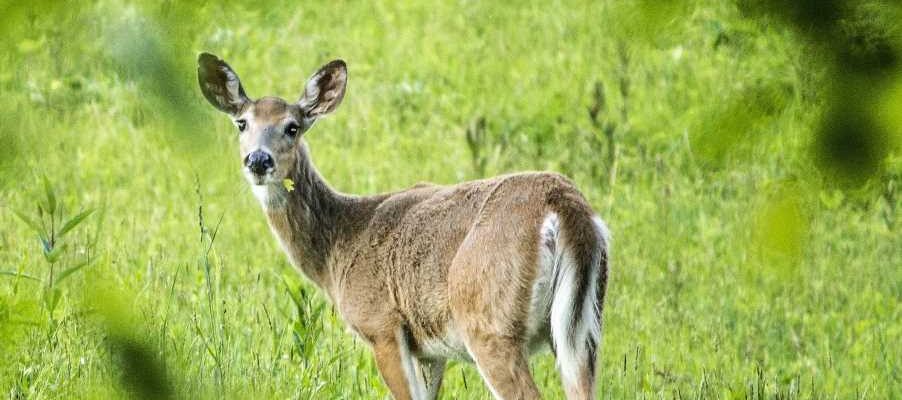SARS-CoV-2 is moving between humans and wildlife around the US

In 2020, Denmark culled millions of mink to quell a source of zoonotic COVID-19 transmission, the passage of the SARS-CoV-2 virus between humans and animals. Last year, zoo animals including lions, tigers, and gorillas got sick with the virus, presumably infected by their keepers. And earlier this year, pet hamsters were implicated in precipitating a new outbreak in Hong Kong.
Before the COVID-19 pandemic, coronaviruses were known to cause certain varieties of the common cold as well as diseases important in animal populations. As the pandemic has stretched on, it’s become clear that SARS-CoV-2 has a penchant for infecting a wide range of animal species.
With a virus so competent at jumping species, the fear is that—even if the pandemic is wrestled under control in human populations—the virus could remain in an animal population, ready to jump back over species borders once again to start the cycle of human infection anew.
“The danger is that it can form an animal reservoir that can spill back into humans,” says Frederic Bushman, a microbiologist at Penn’s Perelman School of Medicine. “That is believed to have happened with mink. Whenever the virus persists, there is an opportunity for additional evolution, for the virus to change.”
And while there isn’t evidence of that happening to a significant degree, research by scientists around the United States, including a team at Penn, suggests that these reservoirs may already exist.
Last year, a Penn State University-led investigation into SARS-CoV-2 infection in white-tailed deer in Iowa found high rates tested positive for the virus. A prior study by the U.S. Department of Agriculture found 40% of deer tested had antibodies, a sign they had had previous exposure to the virus. And earlier this month, the omicron variant was found in deer in New York. Altogether, SARS-CoV-2 has been found in white-tailed deer in 15 states.
“White-tailed deer are at the top of a list of animal species that have cellular receptor binding sites that allow them to be infected by SARS-CoV-2,” says Eman Anis, a veterinary microbiologist at the School of Veterinary Medicine. “If you think about what you need to have a reservoir, you need the species to be infected at a relatively high percentage and be able to spread the infection from one animal to another. All these criteria are met with what we are seeing in deer.”
In a recent study, Anis, as well as Bushman, doctoral student Andrew Marques, wildlife disease ecologist Erick Gagne of Penn Vet, and colleagues aimed to get a broad look at the prevalence of the virus in deer across the state of Pennsylvania. The Wildlife Futures Program, a partnership between the School of Veterinary Medicine and the Pennsylvania Game Commission, helped facilitate sample collection.
“We were interested in trying to use our network to get a widespread set of samples, so we would have a better idea of the spatial distribution and prevalence of the virus in deer,” says Gagne.
Working through Wildlife Futures, the researchers obtained nasal swabs from 93 hunter-killed or road-killed deer during fall and winter of 2021. Of these, 18 tested positive with a PCR test, or 19% of those sampled, across 10 of 31 counties sampled, representing various regions of the state.
Seven of these positive samples underwent whole-genome sequencing in Bushman’s lab, which has been sequencing human samples and tracking variants since the start of the pandemic and maintains a dashboard of their results, representing nearly 5,000 whole genome sequences. Of the deer samples, two were from the alpha variant of SARS-CoV-2, and five from the delta variant. The findings have been published on a preprint server, MedRXiv, and have not yet been subject to peer review, but are the first written reports of delta and alpha in deer, Bushman says.
The two alphas, the researchers noticed, were different enough to suggest that the virus had jumped from humans to deer two different times. And of note, there was no alpha circulating in people at the time the alpha was detected in deer—delta had unseated alpha as the dominant variant.
“Alpha peaked in people in April and May,” Bushman says, “but we’re seeing it in deer in November, long after it’s gone in humans. It’s suggestive that the alpha variant has been circulating in deer in Pennsylvania for quite a long time.”
The delta samples also fell into two distinct groups, “which looks like potentially two independent spillover events,” Gagne says. “Those sequences match more closely to what was circulating within people at the time of sampling.”
Though the researchers urge caution in interpreting their results, the findings, together with those of other groups, offer evidence that “deer getting infected isn’t a one-off or rare event,” says Gagne.
Deer aren’t generally thought of as animals that interact closely with humans on a regular basis. It remains something of a mystery how humans might have repeatedly passed infections to the animals. People feeding deer, captive deer, or even contact with virus-laden wastewater are all being considered as possibilities.
“Now that we are aware that deer can be infected—indeed a huge percentage are positive—we need to keep digging,” Anis says.
In the coming months, these Penn researchers plan to do just that, aiming to expand their testing of wild deer and incorporate testing of other wildlife species.
Source: Read Full Article
